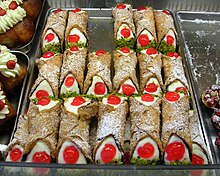Cannoli
 A basic cannolo lightly sprinkled with confectioner's sugar | |
| Alternative names | Cannolo, singular |
|---|---|
| Type | Pastry |
| Place of origin | Italy |
| Region or state | Sicily |
| Main ingredients | fried pastry dough, ricotta filling |
| Variations | Kannoli (Malta) |

Cannoli (Italian pronunciation: [kanˈnɔːli]; Sicilian: cannula) are Italian pastries of the Sicily region. The Italian singular is cannolo ([kanˈnɔːlo]; in the Sicilian language cannolu), meaning "little tube" but in English, cannoli is usually used as a singular, and cannolo is rare.[1] Cannoli originated in Sicily and are a staple of Sicilian cuisine.[2][3] They are also popular in Italian-American cuisine. In Italy, they are commonly known as "cannoli siciliani", Sicilian cannoli.
Cannoli consist of tube-shaped shells of fried pastry dough, filled with a sweet, creamy filling usually containing ricotta. They range in size from "cannulicchi", no bigger than a finger, to the fist-sized proportions typically found south of Palermo, Sicily, in Piana degli Albanesi.[3]
Etymology
Cannolo is a diminutive of canna 'cane or tube'.[4]
History
Cannoli come from the Palermo and Messina[5] areas and were historically prepared as a treat during Carnevale season, possibly as a fertility symbol; one legend assigns their origin to the harem of Caltanissetta. The dessert eventually became a year-round staple throughout Italy.
Some similar desserts in Middle Eastern tradition include Zainab's fingers, which are filled with nuts,[6] and qanawāt, deep fried dough tubes filled with various sweets, which were a popular pastry across the Islamic world at the time, from Al-Andalus to Iraq. The dish and the name may have survived from the Muslim Emirate of Sicily.[7]
References
- ^ Oxford English Dictionary, 3rd edition, 2003 s.v.
- ^ Gangi, Robert (2006). "Cannoli". bestofsicily.com. Retrieved 15 May 2014.
- ^ a b "The Cannoli of Piana degli Albanesi". A Taste of Travel. Retrieved 15 October 2014.
- ^ Oxford English Dictionary, 3rd edition, 2003, s.v.]
- ^ "Scatti di gusto - 30 cannoli siciliani perfetti per un tentativo di classifica definitiva". Scatti di Gusto. Retrieved 15 October 2014.
- ^ Michael Krondl (2011). Sweet Invention: A History of Dessert. Chicago Review Press. p. 102. ISBN 9781556529542.
- ^ Paul H. Freedman (2007). Food: The History of Taste (illustrated ed.). University of California Press. p. 159. ISBN 9780520254763.
